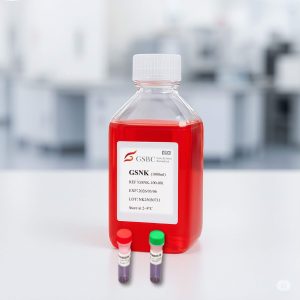產品詳情
- 產品名稱:PriGrow™ I 培養基
- 產品類別:培養基
- 產品編號: TM001
- 包裝規格: 500 mL
- 成分配方: 無血清、無抗生素的基礎培養基
- 外觀: 液體
- pH 範圍: 7.15-7.25
- 滲透壓: 270-310 mOsm/kgH₂O
- 內毒素含量: ≤ 1 EU/mL
- 無菌測試: 通過
- 儲存條件: 2-8°C
- 運輸條件: 冰袋運輸
產品概述
PriGrow™ I Medium 是專為哺乳動物細胞培養所設計的高效基礎培養基。此培養基提供極大的實驗靈活性,使用者可根據需求額外添加特定生長因子、血清或抗生素。每一批產品均經過嚴格的品質控管,以確保穩定的無菌環境、適當的 pH 平衡、最佳的滲透壓,並將內毒素水平降至最低。
此培養基適用於多種細胞培養應用,包括原代細胞培養、永生化細胞株擴增,以及細胞訊號傳遞與分化相關的研究。
主要特點與優勢
- 無血清、無抗生素配方: 提供最大化的實驗靈活性,適用於多種下游應用。
- 最佳化細胞生長環境: 經過測試與驗證,可穩定支持多種哺乳動物細胞培養。
- 高純度、低內毒素: 嚴格的品質控管確保無菌與低內毒素水準。
- 可依需求補充添加成分: 可根據實驗需求額外添加特定生長因子或血清,以達到最佳培養效果。
- 穩定的批次間一致性: 每一批次皆經過 pH、滲透壓與無菌測試,確保穩定性與可重複性。
主要成分及特殊添加物
- L-谷氨酰胺: 102.63 mM
- 葡萄糖: 4.77 mM
品質控管(QC)
每一批次的 PriGrow™ I Medium 均經過嚴格的品質控管,以確保其穩定性與可靠性。品質檢測項目包括:
- 細胞培養性能測試: 針對貼附率(如適用)、細胞形態與代謝活動進行評估。
- 無菌測試: 確保無微生物或真菌污染。
- 物理化學性質測試: pH 值與滲透壓檢測。
- 內毒素篩選: 保證低內毒素環境,確保敏感細胞培養的安全性。
注意事項
本產品僅供研究使用,不可用於治療、診斷或臨床應用。本產品僅限於實驗室研究,不可用於人體試驗或醫療用途。
免責聲明
- 本產品僅限於實驗室研究使用,不得用於人類或醫療相關應用。
- 本公司不對本產品在任何未經批准用途上的準確性、完整性或適用性提供任何保證。
- 本產品之文獻引用僅供參考,並不代表本公司對特定研究結果之認證或背書。
參考文獻
- Gong, Bin, et al. “Exchange protein directly activated by cAMP plays a critical role in bacterial invasion during fatal rickettsioses.” Proceedings of the National Academy of Sciences 110.48 (2013): 19615-19620.
- Gong, Bin, et al. “Compartmentalized, functional role of angiogenin during spotted fever group rickettsia-induced endothelial barrier dysfunction: evidence of possible mediation by host tRNA-derived small noncoding RNAs.” BMC infectious diseases 13 (2013): 1-16.
- Gong, Bin, et al. “Rickettsiae induce microvascular hyperpermeability via phosphorylation of VE-cadherins: evidence from atomic force microscopy and biochemical studies.” PLoS neglected tropical diseases 6.6 (2012): e1699.
- Gong, Bin, et al. “Methods of treating rickettsia using exchange proteins directly activated by camp (epacs) inhibitors.” U.S. Patent Application No. 14/455,325.
- Hansen, Kellisa, et al. “Feasibility investigation of cellulose polymers for mucoadhesive nasal drug delivery applications.” Molecular pharmaceutics 12.8 (2015): 2732-2741.
- Jeyabal, Prince, et al. “MicroRNA-9 inhibits hyperglycemia-induced pyroptosis in human ventricular cardiomyocytes by targeting ELAVL1.” Biochemical and biophysical research communications 471.4 (2016): 423-429.
- Lai, I-Lu, et al. “RETRACTED: Targeting the Warburg effect with a novel glucose transporter inhibitor to overcome gemcitabine resistance in pancreatic cancer cells.” Carcinogenesis 35.10 (2014): 2203-2213.
- Jeyabal, Prince, et al. “MicroRNA-9 inhibits hyperglycemia-induced pyroptosis in human ventricular cardiomyocytes by targeting ELAVL1.” Biochemical and biophysical research communications 471.4 (2016): 423-429.
- Li, Yan, et al. “Oncolytic Ad co-expressing decorin and Wnt decoy receptor overcomes chemoresistance of desmoplastic tumor through degradation of ECM and inhibition of EMT.” Cancer letters 459 (2019): 15-29.
- Liu, Qi, et al. “Use of polymeric nanoparticle platform targeting the liver to induce treg-mediated antigen-specific immune tolerance in a pulmonary allergen sensitization model.” ACS nano 13.4 (2019): 4778-4794.
- Liu, Qiong, et al. “The role of R-spondin 1 through activating Wnt/β-catenin in the growth, survival and migration of ovarian cancer cells.” Gene 689 (2019): 124-130.
- Quintela, Marcos, et al. “HBO1 directs histone H4 specific acetylation, potentiating mechano-transduction pathways and membrane elasticity in ovarian cancer cells.” Nanomedicine: Nanotechnology, Biology and Medicine 17 (2019): 254-265.



